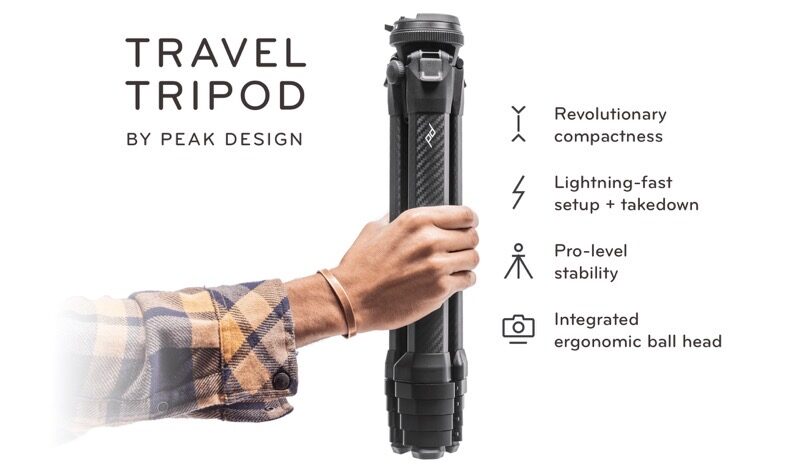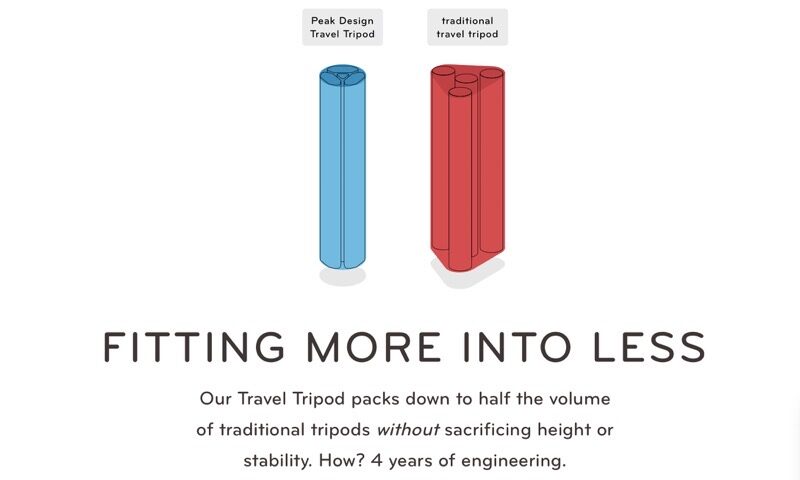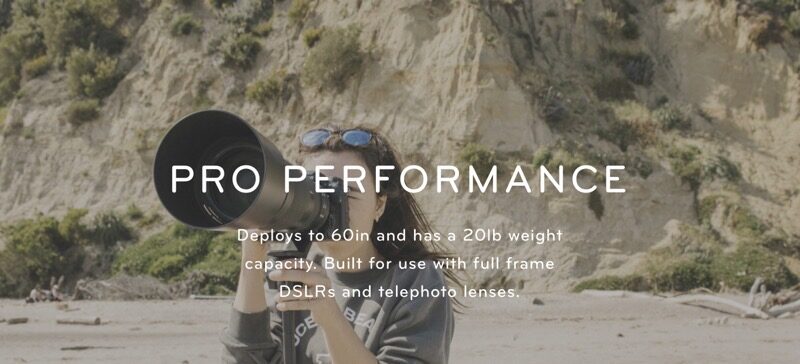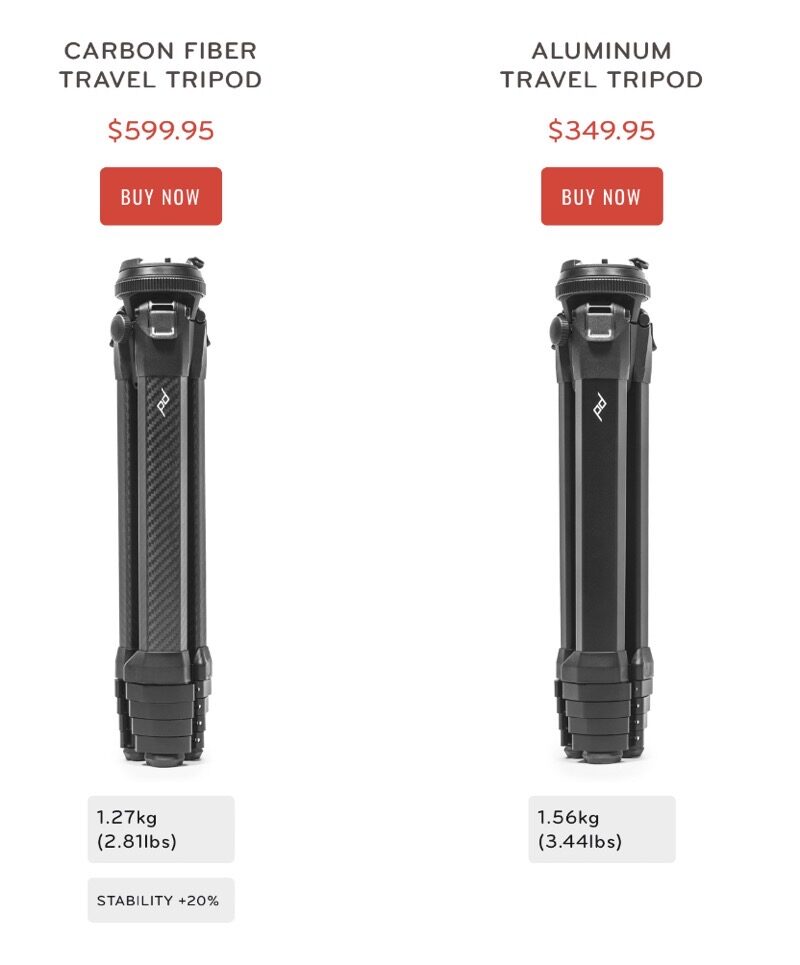The search for the best travel tripod has been a never-ending process. A travel tripod has to be your favourite companion during your trips. A stable, adaptable, tripod wouldn’t suffice, it has to be compact, lightweight and portable. The market is rife is with tripods catered towards various requirement, but a portable tripod has been elusive.
The Peak design travel tripod may have ended our search for a tripod. It fits into a travel backpack (like the Peak Design Travel Backpack) and sturdy enough to handle long exposures in different terrains and conditions. Let’s look into the details of the design that made it possible.

Peak Design Travel Tripod Review
Peak Design Travel Tripod Design
Peak Design travel tripod is an output of a design that intends to minimise the negative space in every possible way. The legs of the tripod exemplify the nature of the design. To get rid of the empty spaces that accompany the circular legs, the Peak design curated triangle-shaped legs. These legs resemble three large pieces carved out of a circle.
To utilise the space, the legs of the tripod slide into the apex metal plate that holds the entire setup. The centre column locks beneath the leg hinges, leaving room for the ball head to fit within. The precise design keeps the leg in proximity to the centre column while leaving room for the leg extensions to fit. The placement of the apex is part of an aesthetic design, which has an inconspicuous presence in the retracted mode.
1. Peak Design Travel Tripod Ball Head:
The peak design ball head sits above the centre column surrounded by retracted tripod legs. The stem connects the ball head to the centre column keeping all the locking mechanism confined to the top of the head. This Peak Design tripod’s design comes with an advantage of ball fitting into the apex. It reduces the size by efficiently utilising the space. The locking clamps are the lone component sticking outside in a seamless structural design.
The normal screws and levers were out of the question for this design. The clamp on the Peak Design head uses a spring clamp to grip the plate. It avoids any protrusion that steers-off from the initial design. The rotating ring deploys an internal cam mechanism to lock the plate it in place. A clockwise-rotation using the thumb rest activates the lock.
The Peak Design ball head doesn’t support panning capability. I wonder if it was a compromise to stay true to their design criteria of being light-weight and compact.Any addition would increase the tripod’s overall folded length and weight.
Videographers can consider the recommended Universal head adapter to use other heads with panning as a workable solution. Considering the price tag, it would have been a bonus if this was part of the tripod package. The ball head design requires a lifted centre column to allow room for camera movements. It emphasizes the core design of compactness.
2. Peak Design Travel Tripod Center column:
The centre column fits between the legs. With an unusual non-circular shape, it is one of narrower than most of the tripods available in the market. The carbon fibre version of the travel tripod uses an aluminium centre column. The isotropic torsional strength property of aluminium was a better suit than the uni-directional stiffness of carbon fibre.
Peak design gets rid of the common twist locks, butterfly knobs to save the space, and uses a thumbscrew to secure the centre column. While the centre column may seem narrower, it doesn’t compromise the stability in this tripod. But there is no guarantee that this centre column design work with other taller tripods without compromising the stability.

3. Peak Design Travel Tripod Legs/Flip Locks:
The Peak design tripod legs comprise five sections either made of carbon fibre or aluminium. The legs use flip locks to extend and retract. Since the design makes the legs triangular, it leaves us with limited possibility of using twist locks. Peak Design has incorporated metal flip locks of higher quality, which has a superior finish, feel and durability. The operation of the flip locks is smooth and demands minimal effort. The design ensures this is one of the fastest leg locks to fold/unfold.
4. Peak Design Travel Tripod Low Mode/Inverted Mode:
The centre column can detach and accommodate lower heights. Peak design provides a hex-key. It allows you to dismantle the centre column into two pieces. The key can unscrew centre column and separate 2/3-rds of the aluminium material attached to the ball head. It allows achieving heights closer to the ground level. This makes the height feasible for macro/product photography and abstract photography using wide-angle lenses. This peak design tripod can switch to an inverted mode to lower the camera to the ground without using the hex key.
5. Peak Design Travel Tripod Phone mount:
The Peak design has put a weight hook at the end of the centre column. A twist on the weight hook unravels a smartphone clamp stowed inside the column. This adjustable phone mount can fit most of the smartphones in the market.
Peak Design Travel Tripod Specifications:
- Weight: Carbon Fibre – 2.81 lbs (1.27 kg) ; Aluminium – 3.44 lbs(1.56 Kg)
- Load Capacity: 20 lbs
- Packed Height: 15.5 inches (39.4 cm)
- Packed width: 3.25 inches (8.3 cm)
- Maximum Height (w/ Center Column): 60 inches (152.4 cms)
- No of Sections: 5
- Leg Angle (Primary): 23.0 degrees
- Lock type (Legs): Flip locks
- Counter Balance Hook: Yes
Peak Design Travel Tripod Build Quality
The Peak design is popular for its usage of high-quality material. This Peak design travel tripod comprises a metal, carbon fibre, and the inevitable plastic. The tripod comes in two variants, an aluminium and carbon fibre version.
The carbon fibre is lightweight and offers better stability compared to its aluminium counterpart at a higher price. The usage of plastic components is limited to the parts which leave a minimal effect on build and stability of the tripod. For example, the covers above the flip locks use plastic as its raw material. The metal parts constitute of a scratch-resistant aluminium with a classy matte black design. The lifetime warranty from Peak design leaves little doubt on the long-term durability of the materials and the quality of the product.

Pros of The Peak Design Travel Tripod
1. Compact/Lightweight
The peak design, with its innovative design, has removed the extra space, keeping it compact to fit inside a backpack. The raw materials used in the tripod is inline with design, making it lightweight and making it an unobtrusive travel partner.
2. Load capacity & Stability
With a load capacity of 20 pounds, Peak design found the optimal balance between load capacity, light-weight, and compact. The aluminum centre column with its counterweight hook and stiff carbon fibre legs ensure the tripod delivers on the stability front.
3. Snug fit tripod cover
The peak design travel tripod comes in a snug fit grey carrying case. The waterproof fabric offers an extra layer of protection if it stays outside the bags. It protects your photography gears (camera, lens) from your tripod if the tripod stays inside your backpack. The carrying case tucks in the hex key that comes with the tripod.
Cons of the Peak Design Travel Tripod
1. Height
The peak design can reach up to five feet, which may uncomfortable for taller people.
2. Hex-Key based design
Hex-key forms a part of the design to attach/ re-attach plates, adjust the centre column etc. While it keeps the tripod compact, it might take some time to overcome the comfort zone of traditional levers and knobs.
3. Panning
Designed for photographers, the ball head doesn’t support panning function, which can be a turn-off for videographers. An universal head adapter with this pack will give other tripods a run for their money, despite the price premium.
4. Price
The Peak design travel tripod stays true to its design in providing lightweight, compact tripods with stability. It drives the price of the product into a premium category.

Key Features of The Peak Design Travel Tripod
1. Load capacity
The metric to evaluate the essential ability of the tripod is load capacity. Tripod legs and head can handle a limited weight. Both the legs and head contribute to the stability of the tripod setup. The manufactures specify the load capacity of the tripod as a part of its specification. It doesn’t mean the tripod wouldn’t handle the excess weight. Since stability is the primary factor of a tripod, exceeding the weight might compromise the stability of the setup. It is necessary to consider the weight of your camera, flash and other accessories before evaluating the efficacy of the tripod.
2. Height
Regardless of the full extension of the central column, the maximum height a tripod can achieve is product specific. The tripods cater towards both the shorter and the taller people. One has to be specific about the height before choosing a tripod. Adjusting your height (Bending the Back/knees) to level with the viewfinder frequently is untenable. It is essential to choose the right tripod for your height.
3. Release Plates
The manufacturers come with proprietary designs to hold the camera to the tripod. It is a factor worthy of attention to understand the compatibility of plates to the tripod. If your tripod uses an Arca swiss-plate, it is one of the universally-compatible quick release systems in use.
4. Space requirements
Most of the time a tripod gets left behind owing to its large frame, or weight or both. The main attribute of a travel tripod should be its capacity to fit into a bag and remain lightweight for arduous journeys.
5. Panning function
While the panning ability may be inessential to a photographer, it is indispensable for a videographer. The ability to follow a subject’s motion seamlessly is essential to produce quality videos. The ball head should either support panning or the tripod should support replaceable ball heads.
About Peak Design
Peak Design is an innovative design company, which manufactures travel/everyday backpacks and photography gear. It aims at using sustainable methods to reduce the environmental impact in the due process of designing and manufacturing. Setting high standards in the quality of design and innovation has given Peak design an edge in the niche of premium travel gears. The Peak design travel tripod is their first venture into a tripod market, which has no dearth for brands and products.
Peak Design Travel Tripod Reddit
u/sryiwasdaydreaming – I have the aluminum peak travel tripod and love it. It’s definitely a tad expensive though. I like the size and ergonomics of it. I saved up and splurged on it because I couldn’t find any others I liked
u/removed – I have the carbon fiber one and it’s the best tripod I’ve used.
u/shooterntx – I have had the Peak Aluminum Travel Tripod ($349) since release. It’s been a light and sturdy tripod for everything I’ve thrown at it including some Astro. Love the innovation shown in the head. It goes everywhere I go.
Verdict
Peak Design’s attempt at making a compact and portable tripod have been successful. The innovative design of fitting the legs, Arca ball head, and the centre column within a slim frame is a feat in itself. They achieved this without compromising on the stiffness or stability.

One has to consider that Peak Design didn’t set out to design the stiffest tripod in the market. The weight and bulkiness are the main reason a tripod gets left behind during travel. Peak Design has excelled in providing a solution to the foreknown problem. It is easy to nitpick and complain about the height or panning or missing set of spike feet or its premium price. It is difficult to ignore what it offers, a travel tripod that fits into your backpack. Its a choice one has to make between photography without a tripod or the set of opportunities/instances the tripod brings to the photography.
Leave a Reply